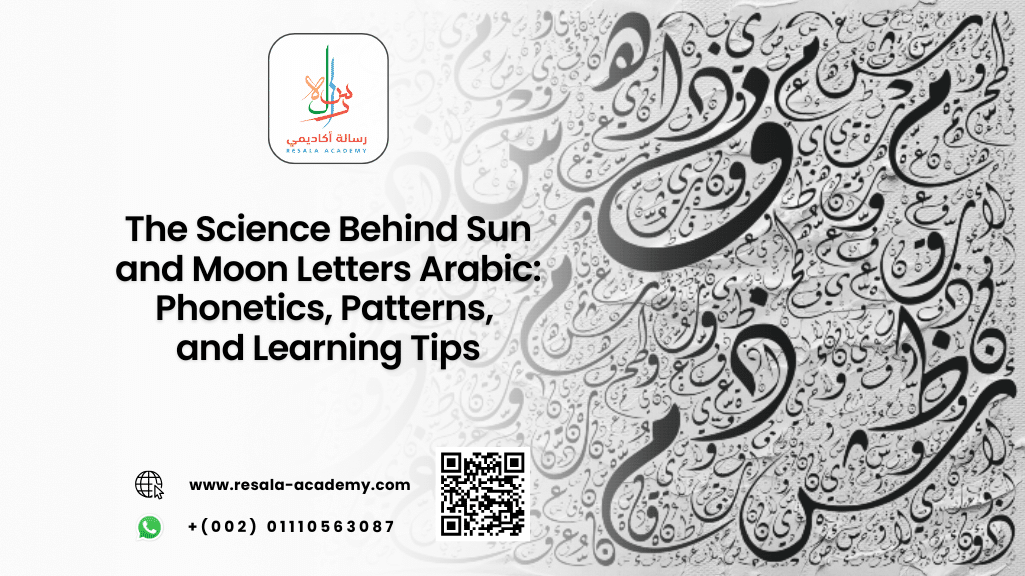Table of Contents
The Science Behind Sun and Moon Letters Arabic: Phonetics, Patterns, and Learning Tips
Learning Arabic, especially for non-native speakers, can be both a fascinating and challenging journey. One of the key foundational concepts in mastering Arabic pronunciation and grammar is understanding the distinction between sun and moon letters Arabic. These categories play a vital role in correct articulation, especially when reading the Quran or engaging in formal Arabic communication.
In this comprehensive guide, we’ll explore the phonetic science behind sun and moon letters, delve into their linguistic patterns, and offer practical tips to help learners master them. Whether you’re a beginner or looking to refine your skills, this article, backed by examples from the Quran and expert insights from Resala Academy, will illuminate your path to fluency.
What Are Sun and Moon Letters in Arabic?
In Arabic, the definite article “ال” (al-) is equivalent to “the” in English. However, its pronunciation changes depending on the first letter of the word it precedes. This phonetic phenomenon divides the Arabic alphabet into two groups:
- Sun Letters (حروف شمسية): These cause the “ل” in “ال” to assimilate or merge with the first letter of the word.
- Moon Letters (حروف قمرية): These allow the “ل” to be pronounced clearly.
This classification is not arbitrary—it’s based on the point of articulation and phonetic properties of each letter.
Confused about Hamzat al-Wasl and Hamzat al-Qat‘? Discover how to identify and use them correctly in Arabic with real examples — start reading now!
The Phonetic Science Behind Sun and Moon Letters
Sun Letters: Assimilation and Pronunciation
Sun letters are characterized by their strong, emphatic sounds. When a word begins with a sun letter, the “ل” in “ال” is not pronounced; instead, the sun letter is doubled (geminated). This is known as idgham (assimilation).
List of Sun Letters:
| Arabic Letter | Transliteration | Example Word | Pronunciation |
|---|---|---|---|
| ت | Taa | التمر (dates) | at-tamr |
| ث | Thaa | الثوب (garment) | ath-thawb |
| د | Daal | الدار (house) | ad-daar |
| ذ | Dhaal | الذهب (gold) | adh-dhahab |
| ر | Raa | الرجل (man) | ar-rajul |
| ز | Zay | الزهر (flower) | az-zahr |
| س | Seen | السماء (sky) | as-samaa’ |
| ش | Sheen | الشمس (sun) | ash-shams |
| ص | Saad | الصبر (patience) | as-sabr |
| ض | Daad | الضيف (guest) | ad-daif |
| ط | Taa | الطالب (student) | at-taalib |
| ظ | Zaa | الظل (shade) | az-zill |
| ل | Laam | الليل (night) | al-layl |
| ن | Noon | النور (light) | an-noor |
Moon Letters: Clarity and Elegance
Moon letters are pronounced clearly after “ال”, maintaining the “ل” sound. This group includes softer, more open sounds.
List of Moon Letters:
| Arabic Letter | Transliteration | Example Word | Pronunciation |
|---|---|---|---|
| أ | Alif | الأسد (lion) | al-asad |
| ب | Baa | الباب (door) | al-baab |
| ج | Jeem | الجمل (camel) | al-jamal |
| ح | Haa | الحصان (horse) | al-hisaan |
| خ | Khaa | الخبز (bread) | al-khubz |
| ع | Ain | العنب (grapes) | al-‘inab |
| غ | Ghayn | الغزال (gazelle) | al-ghazaal |
| ف | Faa | الفيل (elephant) | al-feel |
| ق | Qaaf | القمر (moon) | al-qamar |
| ك | Kaaf | الكتاب (book) | al-kitaab |
| م | Meem | المسجد (mosque) | al-masjid |
| هـ | Haa | الهواء (air) | al-hawaa’ |
| و | Waaw | الورق (paper) | al-waraq |
| ي | Yaa | اليمن (Yemen) | al-yaman |
Quranic Examples of Sun and Moon Letters
Understanding sun and moon letters is especially important when reading the Quran, where precise pronunciation (tajweed) is essential.
Sun Letter Example:
Arabic: وَالشَّمْسِ وَضُحَاهَا
Transliteration: Wa ash-shamsi wa ḍuḥāhā
Translation: “By the sun and its brightness”
Surah: Ash-Shams 91:1
Here, “الشمس” begins with the letter “ش” (Sheen), a sun letter. The “ل” in “ال” is assimilated, resulting in “ash-shams”.
Moon Letter Example:
Arabic: وَالْقَمَرِ إِذَا تَلَاهَا
Transliteration: Wa al-qamari idhā talāhā
Translation: “And [by] the moon when it follows it”
Surah: Ash-Shams 91:2
In “القمر”, the letter “ق” (Qaaf) is a moon letter, so the “ل” in “ال” is clearly pronounced: “al-qamar”.
Advanced Applications of Sun and Moon Letters Arabic in Quranic Morphology and Syntax
Understanding the deeper implications of Sun and Moon Letters Arabic extends beyond pronunciation—it plays a pivotal role in Quranic morphology (ṣarf) and syntax (naḥw), especially for students aiming to decode the linguistic beauty of the Quran. These letters influence grammatical constructs and help learners identify patterns in Quranic verses that are essential for tafsir (interpretation) and memorization.
Grammatical Harmony in Quranic Structure
- Sun letters often appear in nouns and verbs that require assimilation for rhythmic consistency in Quranic recitation. This phonological alignment supports the melodic flow of verses, enhancing both memorization and spiritual immersion.
- Moon letters, due to their clarity, are frequently used in verses emphasizing divine attributes or clear commands, where precision in articulation is paramount.
Morphological Implications in Word Formation
- The presence of a sun or moon letter at the beginning of a word can affect the application of certain morphological rules, such as noun derivation or verb conjugation, especially when the definite article “ال” is prefixed.
- For example, in the word الذِّكْر (adh-dhikr, “the remembrance”), the sun letter “ذ” triggers assimilation, which subtly alters the rhythm and emphasis of the verse. This is crucial in understanding the morphological structure of Quranic vocabulary.
Syntax and Semantic Emphasis
- In Arabic syntax, the use of sun letters often correlates with emphasis or intensity in meaning. This is particularly evident in imperative forms or divine oaths, where assimilation adds phonetic weight.
- Moon letters, by allowing the “ل” to be pronounced, create a pause or clarity that can change the semantic weight of a phrase—ideal for verses requiring reflection or contemplation.
Pedagogical Value for Advanced Learners
- For students at intermediate or advanced levels, analyzing how sun and moon letters interact with grammatical rules deepens their understanding of Quranic eloquence (balāghah).
- This knowledge is especially beneficial for learners enrolled in structured programs like those at Resala Academy, where curriculum modules integrate phonetics with syntax and morphology.
Integrating Sun and Moon Letters Arabic into Tajweed Mastery and Quran Memorization
For non-native speakers pursuing excellence in tajweed and hifz (memorization), mastering the nuances of Sun and Moon Letters Arabic is not optional—it’s essential. These phonetic rules are embedded in the science of tajweed and directly impact the accuracy and beauty of Quran recitation.
Precision in Tajweed Rules
- Sun letters are closely tied to the rule of idgham shamsi, where the “ل” is merged with the following letter. Misapplying this rule can lead to tajweed errors that affect the meaning of the verse.
- Moon letters require iẓhār (clear articulation), which is vital in maintaining the integrity of Quranic pronunciation, especially during public recitation or prayer.
Enhancing Memorization Through Phonetic Patterns
- Recognizing whether a word begins with a sun or moon letter helps learners anticipate pronunciation patterns, making memorization more intuitive.
- The rhythmic assimilation of sun letters often aligns with the natural cadence of Quranic verses, aiding auditory learners in internalizing longer passages.
Avoiding Common Recitation Mistakes
- One of the most frequent errors among beginners is misidentifying a sun letter and incorrectly pronouncing the “ل” in “ال”, which can distort the verse. Structured drills and guided recitation, such as those offered by Resala Academy, help correct these habits early on.
- By integrating sun and moon letter recognition into daily practice, learners build a strong phonetic foundation that supports long-term fluency and confidence.
Spiritual and Cognitive Benefits
- Accurate application of sun and moon letter rules not only improves linguistic skills but also deepens spiritual connection, as learners engage more mindfully with each verse.
- This dual benefit—cognitive and spiritual—is a hallmark of holistic Quranic education, a philosophy embraced by Resala Academy in all its Arabic and Quran programs.
These advanced insights into Sun and Moon Letters Arabic enrich the learner’s journey, transforming technical rules into meaningful tools for deeper Quranic understanding and eloquent Arabic expression.
Patterns and Linguistic Insights
The classification of sun and moon letters is not random. It is based on:
- Point of articulation: Sun letters are pronounced with the tongue touching or approaching the roof of the mouth.
- Acoustic clarity: Moon letters are more open and less emphatic, allowing the “ل” to be heard distinctly.
This phonological distinction enhances the rhythm and flow of Arabic, especially in poetic and religious texts.
Learning Tips for Non-Native Speakers
Mastering sun and moon letters is essential for accurate reading, especially in Quranic recitation. Here are some effective strategies:
Visual Mnemonics
- Create flashcards with sun and moon letters.
- Use color-coding (e.g., yellow for sun, blue for moon).
Repetition and Listening
- Listen to Quran recitations by expert Qaris.
- Repeat after them, focusing on the definite article pronunciation.
Practice with a Tutor
- Enroll in structured Arabic classes, such as those offered by Resala Academy, where expert teachers guide you through phonetics and tajweed.
Use of Apps and Tools
- Leverage apps like Tajweed Quran that highlight sun and moon letters during recitation.
Why Resala Academy is Your Best Choice
Resala Academy is a leading online academy dedicated to teaching Arabic and the Quran to non-native speakers. Their curriculum is designed to simplify complex linguistic concepts like the sun and moon letters Arabic, making them accessible and engaging.
What Sets Resala Academy Apart?
✅ Native Arab instructors with Ijazah certifications
✅ One-on-one and group classes tailored to your pace
✅ Focus on Quranic Arabic and Tajweed
✅ Interactive learning tools and real-time feedback
✅ Affordable pricing and flexible scheduling
Unlock the secrets of Meem Saakin with clear explanations and examples—perfect your Quran recitation today by reading this essential guide now about Meem Saakin rules!
Ready to master the beauty of Arabic pronunciation and Quranic recitation?
Join thousands of learners worldwide who trust Resala Academy to guide them through the intricacies of the Arabic language. Whether you’re starting from scratch or aiming to perfect your tajweed, Resala’s expert tutors are here to help you every step of the way.
Enroll Now and take your first step toward fluency and spiritual connection.
Frequently Asked Questions (FAQs)
1. What are the sun and moon letters in Arabic?
Sun and moon letters refer to two groups of Arabic letters that affect the pronunciation of the definite article “ال”. With sun letters, the “ل” is assimilated (not pronounced), while with moon letters, it is clearly articulated.
2. How can I easily remember which letters are sun or moon?
Use mnemonic devices or visual aids. For example, the word “شمس” (sun) starts with a sun letter, and “قمر” (moon) starts with a moon letter. Flashcards and repetition are also effective.
3. Why is it important to learn the sun and moon letters for Quran recitation?
Correct pronunciation is essential in Quranic recitation (tajweed). Mispronouncing the sun and moon letters can change the meaning of words or make the recitation incorrect.
🔗 Explore the tajweed rules and their importance.
4. Can I learn sun and moon letters online?
Absolutely! Platforms like Resala Academy offer specialized courses that cover sun and moon letters, pronunciation, and Quranic recitation for non-native speakers.
🔗 Sign up for a free trial class.
5. Are the sun and moon letters unique to Arabic?
Yes, this phonetic feature is unique to Arabic and is deeply embedded in its grammar and pronunciation rules. It reflects the language’s rich oral tradition and poetic structure.
Conclusion
Understanding the science behind the sun and moon letters Arabic is more than a linguistic exercise—it’s a gateway to mastering the language of the Quran. By learning the patterns, practicing pronunciation, and applying these rules in context, learners can significantly enhance their fluency and spiritual connection.
With expert guidance from Resala Academy, non-native speakers can confidently navigate these foundational concepts and progress toward eloquent, accurate Arabic.
Don’t just learn Arabic—live it, speak it, and connect with its divine beauty through Resala Academy. Start your journey today at Resala Academy and experience the transformative power of learning Arabic the right way.




